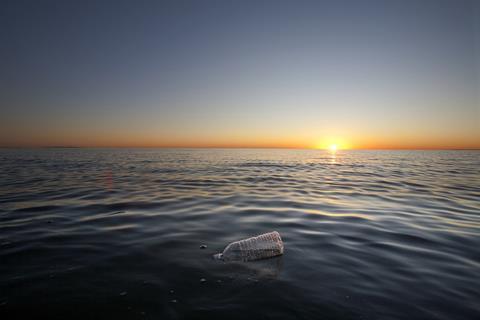
Photo by Justin Hofman, National Geographic
National Geographic and Sky Ocean Ventures have launched a global search for alternatives to single-use plastics. Libby White asks Valerie Craig, Deputy to the Chief Scientist at the National Geographic Society to explain the motivation behind the challenge.
The Ocean Plastic Innovation Challenge, a one-year competition, will focus on three strategic ways to address the growing issue of plastic pollution: designing alternatives to single-use plastics, identifying opportunities for industries to address plastic waste throughout supply chains, and communicating the breadth of the issue through data visualisation.
Teams or individuals interested in the Ocean Plastic Innovation Challenge must submit their solutions by June 11, 2019, for review by an expert judging panel. Selected teams will compete for a share of $1.5 million in awards and investment. Winners will be announced in December 2019.
The Ocean Plastic Innovation Challenge is a key component of National Geographic's Planet or Plastic? initiative, a global effort to significantly reduce the amount of single-use plastic that reaches the ocean by raising awareness, elevating science and education, advancing innovation and inspiring action.

LW: Can you please tell me more about your partnership with Sky Ocean Ventures?
VC: Sky and National Geographic have joined forces in the fight to eradicate the destructive impact of plastic litter in the world’s ocean. At National Geographic, we are all about bold people and transformative ideas, and we want people everywhere to step up to help us address the world’s growing plastic waste crisis.
Sky Ocean Ventures was launched in March 2018 with a £25 million cornerstone commitment from Sky and the objective of seeking out investment opportunities in businesses that can help solve the ocean plastic crisis. Through Sky’s incubator and accelerator program, we will be able to scale the solutions that are submitted through the Ocean Plastic Innovation Challenge, to help tackle the world’s single-use plastic problem.
LW: How do you define single-use plastics?
VC: Single-use plastics generally have a functional life of less than a week and are not designed to be repaired or refurbished. Single-use plastics include packaging, bags, bottles, straws, containers, cups, cutlery, and other items. Bioplastics are not exempt from the single-use plastic designation as, in general, biodegradation only occurs under specific circumstances.
Innovations around single-use packaging are a necessary component of addressing the plastic pollution crisis, which is why we created the Design track of the Ocean Plastic Innovation Challenge. The Design Track targets the top consumer plastic waste that pollutes our beaches and coastlines, and incentivises teams to develop design solutions for food packaging and beverage containers. This track also includes a “wild card” category that allows teams to submit solutions for other single-use plastics that do not fall within the food packaging or beverage container categories. We look forward to seeing what sort of innovative solutions we receive in this track to help design improvements to single-use plastic.

LW: Do you think plastic has a place within the sustainability debate for packaging? (For example single-use is designed to help combat food waste). As a society we depend on plastic packaging- how do we begin to address this?
VC: Plastic has certainly revolutionised business, food security, transport, and other key industries. However, single-use plastics in particular are ending up in all of the wrong places. At National Geographic, our explorers are seeing it at the bottom of the ocean to the highest peaks on the planet. Plastic waste threatens our ecosystems, our habitats and species, and potentially even our own human health.
The largest market for plastics by far is packaging materials, items with an average use time of less than six months. Packaging materials account for nearly half of all plastic waste generated globally, and most of that waste ends up in a landfill or in the environment. A holistic approach needs to be taken that ensures we are rethinking the need for single-use plastic materials - how do we reuse products, rethink how we deliver products, redesign products to do not require virgin plastic, etc. - but also how we collect, capture, and contain that waste so that it isn’t ending up in the environment in the first place.
At a minimum we need to be using less types of plastic, and we need to ensure that all plastic that is produced is reusable, recyclable, compostable or biodegradable, AND infrastructure exists that can recycle and compost.
All approaches are needed to help address the plastic waste crisis, but we want to make sure we’re addressing the problem at its source. We’re interested in preventing plastic waste from entering the oceans, which is why the three tracks of the Ocean Plastic Innovation Challenge - Design, Circular Economy, and Data Visualisation- target three key elements that move us away from a single-use plastics economy and change consumer mindsets and behaviours.
LW: Are there any particular innovations, solutions or concepts that already stand out to you today in the marketplace which can help towards positive change?
VC: Once plastic reaches the environment - particularly the ocean - it is extremely difficult and costly to recover. Innovations that prevent plastic from entering the environment in the first place and keep plastic in the value chain are a positive step in the right direction. There have been some interesting ideas for new materials and new business models just in the last 6-12 months - however it has yet to be seen how these will work in the market.
Many other organisations are tackling the plastic pollution crisis through research and development, new programs, and innovation challenges. The plastic pollution crisis is so vast that we need a large portfolio of solutions in the marketplace.
At National Geographic, we believe this global crisis will require a holistic approach and a variety of solutions meeting needs in different parts of the world. We’re excited to see what solutions we receive for the Ocean Plastic Innovation Challenge. This Innovation Challenge is open to problem solvers from around the globe, ages 18 and up. We encourage anyone who’s interested to learn more and submit a solution at oceanplastic-challenge.org before June 11.
LW: Do you think the packaging industry across the supply chain is working well towards a joined-up approach?
VC: Large strides have been made in the last few years as more attention has come to the issue of plastic pollution. There are good models out there for partnership, alliances, and collaboration across the supply chain - but there is always room for improvement. We would like to see more alignment behind the idea that public commitments that are made are measurable, and that the supply chain is transparent in the progress they are making to achieve the commitments.

LW: Is there a danger of Whac-a-Mole? Each time an adversary is 'whacked'- it pops up again somewhere else? In short, could focusing on single-use plastics mean that other factors are overlooked- such as overall efficiencies of different materials used for packaging?
VC: It is critical to think about the full impact of any product that we use - from production to consumption to end-of life. Any alternative that comes online should be evaluated for its likely impact. The Ocean Plastic Innovation Challenge judges will assess the feasibility of the teams’ solutions, taking production and market factors into consideration, as well as the likelihood of the solutions’ scalability and their potential impact.















